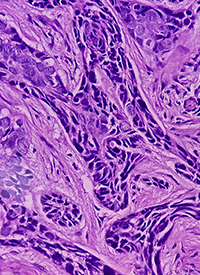PV-10 Elicits Hepatic Responses in Uveal Melanoma With Liver Metastases
Treatment with the novel immunotherapy PV-10 led to hepatic responses in patients with metastatic uveal melanoma with liver metastases, according to updated data from a phase 1 trial.

Treatment with the novel immunotherapy PV-10 (rose bengal sodium) led to hepatic responses in patients with metastatic uveal melanoma with liver metastases, according to updated data from a phase 1 trial (NCT00986661).1
Findings showed that evaluable patients (n = 25) experienced an objective response rate (ORR) in PV-10–injected hepatic lesions of 32%, including a complete response rate of 4% (n = 1) and a partial response rate of 28% (n = 7); 32% of patients (n = 8) achieved stable disease. The disease control rate was 64%.
Safety findings were deemed acceptable, and no mortality or grade 3 or higher morbidities were attributed to study treatment.
“Objective response is uncommon and complete metabolic response [CMR] is rare in metastatic uveal melanoma. PET-CT is not routinely used in this disease; however, early confirmation of response by PET-CT in several subjects suggested its potential importance, and it has since proven valuable for following disease course and documenting durability of response,” Dominic Rodrigues, vice chair of the Provectus’s Board of Directors, stated in a news release. “To confirm these initial results, additional [patients with] M1a [disease] in a dedicated study cohort will receive PV-10 in combination with standard of care ipilimumab [Yervoy] and nivolumab [Opdivo], as well as comprehensive surveillance by PET-CT and expanded immune correlative assessment.”
The open-label phase 1 trial evaluated a single intralesional injection of PV-10 in patients at least 18 years of age with either hepatocellular carcinoma that was not amenable to resection or those with other cancers that have metastasized to the liver.2 All patients needed to have at least one target lesion determined to be amenable to percutaneous injection; at least 1 target lesion with measurable disease; a Karnofsky performance status of at least 60% or an ECOG performance status of 0 to 2; and a life expectancy of at least 12 weeks.
Patients were excluded if they had target lesions that were contiguous with, encompassed, or infiltrated major blood vessels. Hepatic surgery, ablation, chemoembolization, radiation, chemotherapy, or investigational agents were not allowed within 4 weeks of receiving PV-10.
Enrolled patients with uveal melanoma 1 or more cycles of PV-10 as single injection into 1 or more hepatic metastases. Patients were also allowed to received standard-of-care treatment with pembrolizumab (Keytruda) monotherapy or the combination of nivolumab and ipilimumab, if appropriate.1
The incidence of treatment-emergent adverse effects served as the trial’s primary end point. Secondary end points included ORR, overall survival (OS), changes in markers of hepatic function, PV-10 distribution, and pharmacokinetics.
Among the 25 patients included in the uveal melanoma cohort, the median age was 64.3 years (Range, 32-80). The majority were male (56%) and had stage M1a disease (68%). Patients received a median of 1 prior line of therapy for metastatic disease, and 48% of patients were refractory to immune checkpoint blockade.
Notably, 64% of patients received at least 2 cycles of PV-10, and 44% of patients received concurrent immune checkpoint blockage with or after PV-10. A median of 2 hepatic lesions (range, 1-10) were injected per patient.
Additional data showed that all patients with M1a disease experienced a median OS of 30.6 months; those with M1a disease treated with PV-10 and concurrent nivolumab/ipilimumab experienced a median OS of 50.0 months.
In 9 patients who underwent a PET/CT scan, 4 patients with M1a experienced durable complete metabolic responses (CMRs). One of these patients received PV-10 monotherapy, and the other 3 were given PV-10 and nivolumab/ipilimumab. All 4 of these patients were alive after a median follow-up of 39 months (range, 24.6-61.6). Patients who achieved a CMR accounted for 24% of all patients with M1a disease and 16% of all patients with uveal melanoma.
References
- Provectus Biopharmaceuticals provides updated data on cancer immunotherapy PV-10 for metastatic uveal melanoma. News release. November 13, 2023. Accessed November 13, 2023. https://www.provectusbio.com/news/press-releases/provectus-biopharmaceuticals-provides-updated-data-on-cancer-immunotherapy-pv-10-for-metastatic-uveal-melanoma/
- A study to assess PV-10 chemoablation of cancer of the liver. ClinicalTrials.gov. Updated November 2, 2022. Accessed November 13, 2023. https://classic.clinicaltrials.gov/ct2/show/NCT00986661



